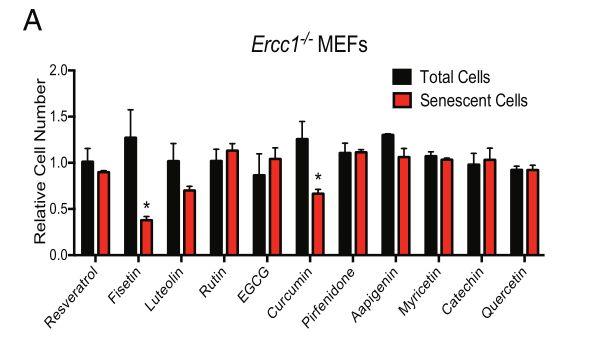Fisetin is a natural flavonoid, which was first isolated and extracted from sumac in 1833. It has antioxidant, anti-inflammatory, anti-tumor, and anti-aging effects.
1. Antioxidants and Inflammation Killers
In 1966, an article published in "Nature" stated that fisetin was one of the flavonoids with the strongest antibacterial effect known at that time, and only 50 μg/ml could effectively inhibit the growth of bacteria such as Staphylococcus aureus. This has drawn scientists' attention to the pharmacological effects of fisetin. In follow-up research on fisetin, scientists found that it has antioxidant and anti-inflammatory properties.
As a flavonoid, fisetin has inherent antioxidant properties. It not only has direct antioxidant activity, but also increases the level of glutathione, the main antioxidant in cells. Even under oxidative stress, fisetin maintains mitochondrial function well, and even very fragile neuronal cells are well protected.
In addition to its own antioxidant talent, its anti-inflammatory effect should not be underestimated. Fisetin inhibits the NF-κB pro-inflammatory signaling pathway by activating β-catenin protein and silencing the expression of TLR4, thereby downregulating the release of inflammatory cytokines and achieving an anti-inflammatory effect.
2.The nemesis of tumors
For the powerful fisetin, anti-oxidation and anti-inflammatory are actually nothing, they are all basic operations, and anti-tumor is its stage. Fisetin plays an inhibitory role in all stages of tumor development, and uses its "thunderbolt" method to treat tumors submissively.
In the early stage of tumors, fisetin can interfere with chromosome segregation and promote DNA double-strand breaks, thereby reducing its proliferation rate. During the period of rapid tumor growth, fisetin can also reduce angiogenesis by inhibiting uPA (urokinase plasminogen activator) and cut off the tumor's nutrient source. In the late stage of the tumor, the tumor may metastasize, and fisetin can prevent the degradation of the ECM protein barrier by inhibiting the key target of MMP-1, thereby preventing tumor cells from entering the blood and inhibiting tumor cell metastasis.
3. Delay aging
It is not only cancer that affects human health and longevity, but also aging. Fisetin is not only satisfied with the status quo of suppressing tumors, but also wants to make a contribution to delaying aging.
In 2007, Sinclair and others discovered that fisetin can activate the SIRT1 longevity protein, and fisetin has emerged in the anti-aging field. After the concept of senolytics proposed by Dr. James Kirkland in 2015, fisetin has become a popular senolytics substance due to its powerful ability to clear senescent cells, which has attracted more attention.
Fisetin exerts its strong anti-aging ability mainly depends on two points, one is as a calorie restriction simulant, and the other is as a senolytics substance.
(1) Calorie restriction simulants
Although calorie restriction (CR) is effective in delaying aging, it is painful to implement and slow to take effect, which makes most people discouraged. Caloric restriction mimics (CRMs) perfectly solve this problem, which can simulate CR and activate the corresponding signaling pathways without reducing caloric intake.
As a caloric restriction mimetic, fisetin induces autophagy by upregulating the expression of SIRT1 in the Sirtuins family, thereby inhibiting mTOR. Unlike other caloric restriction mimics such as metformin, fisetin is tissue-specific and is more effective in promoting autophagy in brain cells.
(2) Senolytics substances
Senolytics refers to the targeted elimination of senescent cells. With the increase of human age, senescent cells will continue to accumulate, and secrete a large amount of SASP (senescence-associated secretory phenotype), which promotes the surrounding normal cells to age, thereby accelerating the aging of the body.
A study in 2018 showed that fisetin had the best effect in removing senescent cells among the 10 flavonoids at that time, and its effect exceeded that of resveratrol, curcumin, and catechin, so it became the focus of scientists' research. Another study showed that fisetin reduced the mortality rate from nearly 100% to 50% after clearing the senescent cells of old mice with Covid-19.

The effect of 10 kinds of flavonoids in removing senescent cells
So how does fisetin achieve such an excellent scavenging effect? The study found that the reason why senescent cells do not apoptosis is that they upregulate the SCAP network (anti-apoptotic pathway). Fisetin blocks the SCAP network (anti-apoptotic pathway) by blocking the PI3k/Akt/mTOR pathway and activating SIRT1, so that senescent cells automatically go to apoptosis.
The study found that the reason why senescent cells do not apoptosis is that they upregulate the SCAP network (anti-apoptotic pathway). Fisetin blocks the SCAP network (anti-apoptotic pathway) by blocking the PI3k/Akt/mTOR pathway and activating SIRT1, so that senescent cells automatically go to apoptosis.
As a natural senolytics substance, fisetin has demonstrated its efficacy and safety in mouse models and human tissues. Clinically, fisetin is currently mainly used in arthritis, osteoporosis, new coronary pneumonia and other indications, and most of its clinical progress is concentrated in the second phase, and most of the clinical results are expected to be released in the second half of this year.

